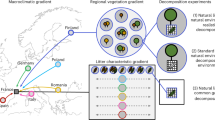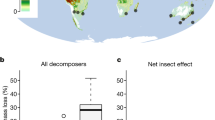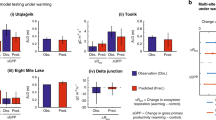Abstract
Decomposition of organic matter strongly influences ecosystem carbon storage1. In Earth-system models, climate is a predominant control on the decomposition rates of organic matter2,3,4,5. This assumption is based on the mean response of decomposition to climate, yet there is a growing appreciation in other areas of global change science that projections based on mean responses can be irrelevant and misleading6,7. We test whether climate controls on the decomposition rate of dead wood—a carbon stock estimated to represent 73 ± 6 Pg carbon globally8—are sensitive to the spatial scale from which they are inferred. We show that the common assumption that climate is a predominant control on decomposition is supported only when local-scale variation is aggregated into mean values. Disaggregated data instead reveal that local-scale factors explain 73% of the variation in wood decomposition, and climate only 28%. Further, the temperature sensitivity of decomposition estimated from local versus mean analyses is 1.3-times greater. Fundamental issues with mean correlations were highlighted decades ago9,10, yet mean climate–decomposition relationships are used to generate simulations that inform management and adaptation under environmental change. Our results suggest that to predict accurately how decomposition will respond to climate change, models must account for local-scale factors that control regional dynamics.
This is a preview of subscription content, access via your institution
Access options
Subscribe to this journal
Receive 12 print issues and online access
$209.00 per year
only $17.42 per issue
Buy this article
- Purchase on Springer Link
- Instant access to full article PDF
Prices may be subject to local taxes which are calculated during checkout



Similar content being viewed by others
References
Wieder, W. R., Bonan, G. B. & Allison, S. D. Global soil carbon projections are improved by modelling microbial processes. Nature Clim. Change 3, 909–912 (2013).
Berg, B. et al. Litter mass-loss rates in pine forests for Europe and Eastern United States: Some relationships with climate and litter quality. Biogeochemistry 20, 127–159 (1993).
Currie, W. S. et al. Cross-biome transplants of plant litter show decomposition models extend to a broader climatic range but lose predictability at the decadal time scale. Glob. Change Biol. 16, 1744–1761 (2010).
Meentemeyer, V. Macroclimate and lignin control of litter decomposition rates. Ecology 59, 465–472 (1978).
Moore, T. R. et al. Litter decomposition rates in Canadian forests. Glob. Change Biol. 5, 75–82 (1999).
Clark, J. S. et al. Individual-scale variation, species-scale differences: Inference needed to understand diversity. Ecol. Lett. 14, 1273–1287 (2011).
Mace, G. M. Ecology must evolve. Nature 503, 191–192 (2013).
Pan, Y. et al. A large and persistent carbon sink in the world’s forests. Science 333, 988–993 (2011).
Harper, J. L. A Darwinian approach to plant ecology. J. Ecol. 55, 247–270 (1967).
Robinson, W. S. Ecological correlations and the behavior of individuals. Am. Sociol. Rev. 15, 351–357 (1950).
Cornwell, W. K. et al. Plant species traits are the predominant control on litter decomposition rates within biomes worldwide. Ecol. Lett. 11, 1065–1071 (2008).
Wall, D. H. et al. Global decomposition experiment shows soil animal impacts on decomposition are climate-dependent. Glob. Change Biol. 14, 2661–2677 (2008).
Bonan, G. B., Hartman, M. D., Parton, W. J. & Wieder, W. R. Evaluating litter decomposition in earth system models with long-term litterbag experiments: An example using the Community Land Model version 4 (CLM4). Glob. Change Biol. 19, 957–974 (2013).
Allison, S. D., Wallenstein, M. D. & Bradford, M. A. Soil-carbon response to warming dependent on microbial physiology. Nature Geosci. 3, 336–340 (2010).
Bradford, M. A. et al. Thermal adaptation of soil microbial respiration to elevated temperature. Ecol. Lett. 11, 1316–1327 (2008).
Norby, R. J., Warren, J. M., Iversen, C. M., Medlyn, B. E. & McMurtrie, R. E. CO2 enhancement of forest productivity constrained by limited nitrogen availability. Proc. Natl Acad. Sci. USA 107, 19368–19373 (2010).
Gholz, H. L., Wedin, D. A., Smitherman, S. M., Harmon, M. E. & Parton, W. J. Long-term dynamics of pine and hardwood litter in contrasting environments: Toward a global model of decomposition. Glob. Change Biol. 6, 751–765 (2000).
Heath, L. S., Smith, J. E. & Birdsey, R. A. in The Potential of US Forest Soils to Sequester Carbon and Mitigate the Greenhouse Effect (eds Kimble, J. M., Heath, L. S., Birdsey, R. A. & Lal, R.) 35–45 (Lewis Publishers CRC Press, 2003).
Cornwell, W. K. et al. Plant traits and wood fates across the globe: Rotted, burned, or consumed? Glob. Change Biol. 15, 2431–2449 (2009).
Harmon, M. E., Bond-Lamberty, B., Tang, J. & Vargas, R. Heterotrophic respiration in disturbed forests: A review with examples from North America. J. Geophys. Res. 116, G00K04 (2011).
Lindenmayer, D. B., Claridge, A. W., Gilmore, A. M., Michael, D. & Lindenmayer, B. D. The ecological roles of logs in Australian forests and the potential impacts of harvesting intensification on log-using biota. Pac. Conserv. Biol. 8, 121–140 (2002).
Crowther, T. W., Boddy, L. & Jones, T. H. Functional and ecological consequences of saprotrophic fungus–grazer interactions. ISME J. 6, 1992–2001 (2012).
Dickie, I. A., Fukami, T., Wilkie, J. P., Allen, R. B. & Buchanan, P. K. Do assembly history effects attenuate from species to ecosystem properties? A field test with wood-inhabiting fungi. Ecol. Lett. 15, 133–141 (2012).
Cornelissen, J. H. C. et al. Controls on coarse wood decay in temperate tree species: Birth of the LOGLIFE Experiment. Ambio 41, 231–245 (2012).
Boddy, L., Frankland, J. C. & van West, P. Ecology of Saprotrophic Basidiomycetes (Academic, 2008).
Treseder, K. K. The extent of mycorrhizal colonization of roots and its influence on plant growth and phosphorus content. Plant Soil 371, 1–13 (2013).
Aerts, R. Climate, leaf litter chemistry and leaf litter decomposition in terrestrial ecosystems: A triangular relationship. Oikos 79, 439–449 (1997).
Adair, E. C. et al. Simple three-pool model accurately describes patterns of long-term litter decomposition in diverse climates. Glob. Change Biol. 14, 2636–2660 (2008).
King, J. R., Warren, R. J. II & Bradford, M. A. Social insects dominate eastern US temperate hardwood forest macroinvertebrate communities in warmer regions. PLoS ONE 8, e75843 (2013).
Ulyshen, M. D. & Wagner, T. L. Quantifying arthropod contributions to wood decay. Methods Ecol. Evol. 4, 345–352 (2013).
Rastetter, E. B. et al. Aggregating fine-scale ecological knowledge to model coarser-scale attributes of ecosystems. Ecol. Appl. 2, 55–70 (1992).
Sutherland, W. J. et al. Identification of 100 fundamental ecological questions. J. Ecol. 101, 58–67 (2013).
Rehfeldt, G. E. et al. Intraspecific responses to climate in Pinus sylvestris. Glob. Change Biol. 8, 912–929 (2002).
Acknowledgements
Thanks to A. Neupane and J. Snajdr for laboratory assistance, and P. Raymond, O. Schmitz, D. Menge and B. Taylor for comments on earlier drafts. For site-use permissions we thank the Florida Department of Environmental Protection (San Felasco Hammock State Park), the US Forest Service (Coweeta Hydrologic Laboratory and Chattahoochee National Forest), the Yale School of Forests (Yale Myers Research Forest) and the Warnell School of Forestry (Whitehall Forest). Wood chemistry was determined by the Yale Earth System Center for Stable Isotopic Studies. Research was supported by US National Science Foundation grants to M.A.B. (DEB-1021098), J.R.K. (DEB-1020415) and the Coweeta LTER Program. P.B. was supported by the RC of the Institute of Microbiology.
Author information
Authors and Affiliations
Contributions
M.A.B. and R.J.W. contributed equally to this work. Together with J.R.K., they conceived and established the study. M.A.B., R.J.W., P.B., T.W.C., E.E.O. and J.R.K. performed field and laboratory work. M.A.B., R.J.W. and S.A.W. analysed data. W.R.W. modelled the decomposition data. M.A.B. wrote the first draft of the manuscript. All authors contributed to data interpretation and paper writing.
Corresponding author
Ethics declarations
Competing interests
The authors declare no competing financial interests.
Supplementary information
Rights and permissions
About this article
Cite this article
Bradford, M., Warren II, R., Baldrian, P. et al. Climate fails to predict wood decomposition at regional scales. Nature Clim Change 4, 625–630 (2014). https://doi.org/10.1038/nclimate2251
Received:
Accepted:
Published:
Issue Date:
DOI: https://doi.org/10.1038/nclimate2251
This article is cited by
-
Suspended Sections Within Downed Deadwood Are Drier, Have Altered Decomposer Communities, and Slower Decomposition
Ecosystems (2024)
-
Decomposition and nutrient dynamics of stumps and coarse roots of Eucalyptus plantations in southern China
Annals of Forest Science (2023)
-
Soil fauna accelerated litter C and N release by improving litter quality across an elevational gradient
Ecological Processes (2023)
-
Dispersal changes soil bacterial interactions with fungal wood decomposition
ISME Communications (2023)
-
Resolving the intricate role of climate in litter decomposition
Nature Ecology & Evolution (2023)



